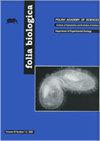What Does the Haired Keel on the Shell Whorls of Potamopyrgus antipodarum (Gastropoda, Tateidae) Mean?
IF 0.8
4区 生物学
Q4 BIOLOGY
引用次数: 0
Abstract
In several ecosystems, Potamopyrgus antipodarum (Gray, 1853) (Gastropoda, Tateidae) is considered among the worst invasive species. Its tolerance to a broad range of environmental conditions has favoured its success in colonising new environments worldwide. However, population crashes may occur, leading to significant fluctuations in snail densities. Such crashes might be linked to morphological changes in the shell whorls, like the emergence of a haired keel (carinatus morphotype). In this study, we investigated the link between the appearance of the carinatus morphotype and the crashes in population densities over three years, based on field observations. The presented results show that after the emergence of the so-called carinatus morphotype, the population of P. antipodarum collapsed and did not recover for the next two years. This may indicate that the carinatus morphotype is a defensive reaction to extremely unfavourable environmental conditions.对足Potamopyrgus antipodarum(腹足目,Tateidae)外壳上的毛龙骨是什么意思?
在一些生态系统中,Potamopyrgus antipodarum (Gray, 1853)(腹足目,扁足科)被认为是最严重的入侵物种之一。它对各种环境条件的耐受性使其在世界范围内开拓新环境方面取得了成功。然而,种群崩溃可能会发生,导致蜗牛密度的显著波动。这种碰撞可能与壳轮的形态变化有关,比如毛龙骨(carinatus形态型)的出现。在这项研究中,我们调查了carinatus形态的出现与种群密度在三年内的崩溃之间的联系。结果表明,在所谓的carinatus形态出现后,P. antipodarum的种群数量急剧下降,并且在接下来的两年内没有恢复。这可能表明,carinatus形态是对极端不利的环境条件的防御反应。
本文章由计算机程序翻译,如有差异,请以英文原文为准。
求助全文
约1分钟内获得全文
求助全文
来源期刊

Folia Biologica-Krakow
医学-生物学
CiteScore
1.10
自引率
14.30%
发文量
15
审稿时长
>12 weeks
期刊介绍:
Folia Biologica (Kraków) is an international online open access journal accepting original scientific articles on various aspects of zoology: phylogeny, genetics, chromosomal studies, ecology, biogeography, experimental zoology and ultrastructural studies. The language of publication is English, articles are assembled in four issues per year.
 求助内容:
求助内容: 应助结果提醒方式:
应助结果提醒方式:


